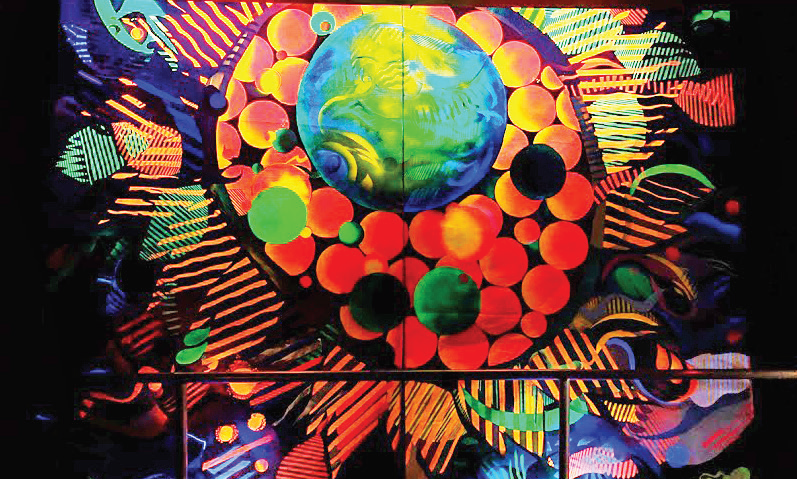A Space for Art
Exploring Alixandra Summit’s Earth from the Moon
The music of The Beatles and the ambition of astronauts were the contextual catalysts for the art of Alixandra Summitt, whose perspective is truly out of this world.
Born in Detroit and then moving to the countryside gave her a unique perspective of urban landscape and environmental isolation that is so prevalent in her work.
Michigan is the third coast of the United States where looking across a great lake feels like being on the edge of the planet. The state is an innovative mixture of nature and civilization, a balance of precious natural resources and industrious hard work.
Alixandra, is the Ansel Adams of space and started creating “The Earth from the Moon: I Don’t Know What You Saw Neil, But…” a week before Neil Armstrong’s famous first steps on the cratered celestial regolith and when the world received its first grainy glimpse of the tide-shifting lunar landscape.
“Everybody knew it was one world up to that point, but we didn’t see it. As visually trained artists we were so aware, but now we are understanding visually what there is as one world, one planet.”
Gazing into the psychedelic color scheme of the piece is an eye-catching extraterrestrial exploration of our planet. The image is enhanced in the black light gallery of the Abrams Planetarium where the talent of Michigan’s most professional colorist shines.
The vibrant colors of the UV-reactive paint illuminate the geometric designs at the focal point of the piece.
The fluorescent paint transcends the canvas and transports the viewer onto the lunar surface.
The relationship between art and science in driving creativity and discovery is abundantly clear in the unique view of the lunar landscape overlooking the planet.
Art and science are inextricably linked in astronomy as an interpretation of light based on data. The human eye can only see between infrared and ultraviolet so to make the science accessible to our perspective contains some artistic subjectivity.
Summitt has a sense of color that was recognized in the art world and it is how she landed this commission as a recent graduate early in her career.
“They really set me free, they didn’t give me a topic or anything, I chose that myself.”
The chosen topic is a reminder of how the inspiration of space is ubiquitous across all time periods. It is a vestigial structure of storytelling, navigation, and the passage of time.
From wandering nomads, to agrarian roots, building societies, and organizing civilizations; space is a pilgrimage of the human spirit. The innate and primal nature of humanities exploration into space continues to remain a part of our collective consciousness.
Summitt’s artwork is grounded in the studio space used to create it. “The studio I had was an old barn and part of the imagery is the holes in the roof shining light onto the canvas because I had rolled it out onto the floor.”
At the time, the word “environment” had just been coined, “it was a phenomenal period in the world because at the same time we believed that everything was possible. The Beatles really were very good at representing that world that was possible, the new frontier. We just believed that we could overcome all the barriers, that’s where the thrust of the 60s came from and so many ideas that are coming into fruition now that took 50 years.”
The avant-garde introspection into the environment which was blossoming at the time as the leading edge of consciousness provides the ambiance of the The Earth from the Moon. “We were seriously looking at how we’re all one and that was the purpose of that painting and my whole career has been around helping people to become more fully aware of everything that’s around us.”
Summitt is an interstellar naturist whose vision is in touch with the outer limits of space travel. Her success has been in bringing the hidden parts of the universe to people’s awareness.
The universal themes of art and science as tools to grasp existence creates a mutually beneficial intersectionality between the diverse academia in contributing to a better understanding of the beauty in both fields.
“Are you a big picture person or are you just focused on one little narrow band of reality? We need both kinds of people, but we can depend on the artist for the big picture and that’s where the scientists can draw upon what’s coming out of the arts.”
“In a planetarium, we’re relying on those visualizations, those interpretations of the data to bring it to life and immerse you in it,” said Shannon Schmoll, Director of Abrams Planetarium. “We always need artists to help us do what we do and also in the other sense science itself can inspire the art that really makes us interested and excited.”
It has been nearly 50 years since July 20th, 1969 when humans first landed on the moon.
Locally, artist Alixandra Summitt commemorated that moment with paintings leading up to the landing.
Three of those commemorative pieces are available for the public to view at Michigan State University’s Abrams Planetarium which was founded in 1964.
The piece focused on in this article is “The Earth from the Moon: I Don’t Know What You Saw Neil, But…” and is a massive painting that could not be displayed in its entirety in the black light gallery. The displayed portion shows the Earth while the moon is safely stored under the piece.
Another shining example of inspiration from The Beatles is “Here Comes the Sun: We All Live in a Yellow Submarine” which showcases the Earth as a yellow submarine as we all propel our imagination through space.
Although all of Summitt’s paintings showcase her talent as a colorist, a mind-bending prime example also on display at the planetarium is “The sea of worms: Wormholes as Access to other Dimensions.”
All three examples of Alixandra Summit’s work are a testament to future landscapes lunar and planetary colonists may observe as we continue our adventurous journey into space.
The edited and published article can be viewed in the electronic edition: City Pulse – May 7th – Summitt Article



